|
|
|
Sort Order |
|
|
|
Items / Page
|
|
|
|
|
|
|
| Srl | Item |
| 1 |
ID:
097208
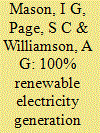

|
|
|
|
|
| Publication |
2010.
|
| Summary/Abstract |
The New Zealand electricity generation system is dominated by hydro generation at approximately 60% of installed capacity between 2005 and 2007, augmented with approximately 32% fossil-fuelled generation, plus minor contributions from geothermal, wind and biomass resources. In order to explore the potential for a 100% renewable electricity generation system with substantially increased levels of wind penetration, fossil-fuelled electricity production was removed from an historic 3-year data set, and replaced by modelled electricity production from wind, geothermal and additional peaking options. Generation mixes comprising 53-60% hydro, 22-25% wind, 12-14% geothermal, 1% biomass and 0-12% additional peaking generation were found to be feasible on an energy and power basis, whilst maintaining net hydro storage. Wind capacity credits ranged from 47% to 105% depending upon the incorporation of demand management, and the manner of operation of the hydro system. Wind spillage was minimised, however, a degree of residual spillage was considered to be an inevitable part of incorporating non-dispatchable generation into a stand-alone grid system. Load shifting was shown to have considerable advantages over installation of new peaking plant. Application of the approach applied in this research to countries with different energy resource mixes is discussed, and options for further research are outlined.
|
|
|
|
|
|
|
|
|
|
|
|
|
|
|
|
| 2 |
ID:
117326


|
|
|
|
|
| Publication |
2013.
|
| Summary/Abstract |
In 2009, Jiangsu province of China supplied 99.6 percent of its total energy consumption with fossil fuels, of which 82 percent was imported from other provinces and countries. With rising energy demand, frequent energy shortages, and increasing pollution, it is essential for Jiangsu to put more emphasis on improving its energy efficiency and utilizing its renewable resources in the future. This paper presents the integrated energy pathway for Jiangsu during its social and economic transformation until 2050. EnergyPLAN is the chosen energy system analysis tool, since it accounts for all sectors of the energy system that needs to be considered when integrating large-scale renewable energy. A current policy scenario (CPS) based on current energy policies and an ambitious policy scenario (APS) based on large-scale integration of renewable energy and ambitious measures of energy efficiency improvement are proposed. The two energy pathways are modeled and compared in terms of technology combination, non-fossil fuel shares of primary energy supply, socioeconomic costs, and CO2 emissions. The insights from these pathways can provide valuable input for Jiangsu's future energy policies.
|
|
|
|
|
|
|
|
|
|
|
|
|
|
|
|
| 3 |
ID:
093475


|
|
|
|
|
| Publication |
2010.
|
| Summary/Abstract |
Water deficits and their associated shortages are serious problems in many areas of the world. The paper presents a multi-criteria analysis for selection of the most suitable system in Mauritania. Six scenarios, different energy sources, technologies of water desalination processes and water use and five criteria are analyzed. The multi-criteria analysis shows that the optimal solution is different for each scenario; in some cases the photovoltaic-reverse osmosis option is preferable; in others, the best option is reverse-osmosis powered by wind energy or concentrating solar parabolic.
|
|
|
|
|
|
|
|
|
|
|
|
|
|
|
|
| 4 |
ID:
125868


|
|
|
|
|
| Publication |
2013.
|
| Summary/Abstract |
In recent years, China has been ambitious in investing and developing renewable energy technologies, aiming to enhance its energy security, mitigate its energy-related CO2 emissions and develop renewable energy industry. The 12th Five Year Plan (2011-2015) has set clear targets on installed capacities of different renewable energy technologies. This study aimed to assess the possible contribution of 12th Five Year Plan for China's future energy system and identify factors that might influence its impacts. First, current status of renewable energy development in China has been reviewed. Then several energy scenarios have been developed in an hourly simulation using an energy system analysis tool EnergyPLAN. It was identified that existing grid bottleneck would greatly reduce the potential contribution of renewable installations in terms of share of renewable electricity generation, share of non-fossil fuels in primary energy and system CO2 emissions. In contrast, improving technical performance of renewable energy technologies and sectoral energy efficiency plays an important role in increasing the share of renewables and promoting China's energy system transition. Finally, some policy suggestions were drawn to facilitate a better implementation of the renewable energy plan.
|
|
|
|
|
|
|
|
|
|
|
|
|
|
|
|
| 5 |
ID:
183036
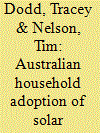

|
|
|
|
|
| Summary/Abstract |
Prior studies establish that electricity systems across the globe need to transition toward renewable energy and that renters have a low adoption of effective means to do so through access to household solar photovoltaics (PV). Yet, the economic, environmental, and social costs of low PV adoption by people who have trouble paying their electricity bills (hardship customers), who are more likely to be low-income tenants, remain understudied. Drawing on electricity use data from an Australian energy retailer we compare the performance of PV for hardship customers against ‘average’ households. Results illustrate that if society could achieve greater solar PV installation on hardship homes, annual grid-based electricity consumption could be reduced by 40%, lowering greenhouse gas emissions by 1.6 tCO2e per household annually and energy bills by $2908 per low-income household over 15 years. We illustrate how Australian policy could be re-oriented to encourage greater PV adoption on hardship properties, including through support for a new market structure that distributes the economic benefits of PV between renters and landlords.
|
|
|
|
|
|
|
|
|
|
|
|
|
|
|
|
| 6 |
ID:
150443
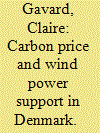

|
|
|
|
|
| Summary/Abstract |
This paper aims at characterizing the conditions of wind power deployment in order to infer a carbon price level that would provide wind power with comparable advantage over fossil fuel technologies as effective wind support policies. The analysis is conducted on Denmark after the electricity market liberalization. Probit and tobit techniques are employed to take account of a potential threshold effect. I find that the level and type of the support policy are the dominant drivers of deployment. A feed-in tariff significantly brings more wind power in than a premium policy. The additional capacity installed monthly increases by more than 1 MW for each additional €/MWh of support. This is compared to the effect of the electricity price, investment cost, interest rate and general economic activity. If the policy is a premium, I find that 23€/MWh of support in addition to electricity price is needed to observe the connection of new turbines to the grid with a 0.5 probability. I convert this support level into a carbon price of 27€/ton if wind power competes with coal, and 48€/t if it competes with gas.
|
|
|
|
|
|
|
|
|
|
|
|
|
|
|
|
| 7 |
ID:
125580


|
|
|
|
|
| Publication |
2013.
|
| Summary/Abstract |
This study investigates the causal relationship between clean and non-clean energy consumption and economic growth in Brazil over the period of 1980-2009. Clean energy consumption at aggregated level of total renewable energy consumption and disaggregated levels of hydroelectric, new renewables, and nuclear energy consumption are tested within a production function framework. A cointegration test reveals a long-term equilibrium relationship between real output, capital, labor, and renewable and non-renewable energy consumption at aggregated level, and a long-term equilibrium relationship between real output, capital, labor, and hydroelectric/new renewables/nuclear and fossil fuel energy consumption at disaggregated level. The capital, labor, and new renewables elasticities of real output are positive and statistically significant, other energy consumption item's elasticities are insignificant. The results from error correction model reveal the interdependencies between new renewables, nuclear, fossil fuel, and total non-renewable energy consumption and economic growth, the unidirectional causality from hydroelectric/total renewable consumption to economic growth, the substitutability between new renewables and fossil fuel consumption, and the substitutability between new renewables and nuclear energy consumption. Additionally, nuclear and new renewables energy consumption responds to bring the system back to equilibrium. Overall, aggregated analysis may obscure the relationship between different types of clean energy consumption and economic growth.
|
|
|
|
|
|
|
|
|
|
|
|
|
|
|
|
| 8 |
ID:
182461


|
|
|
|
|
| Summary/Abstract |
India’s energy security is intricately linked to economic and population growth, accessibility, availability, affordability, and supply and demand. India’s quest for energy security is going slow and after a late start. India embraced various domestic efforts and has drawn up supplier relationships around the globe in coal, oil, gas, nuclear, hydroelectric power, and renewable energy. It appears India is not likely to be fully independent of external sources of supply for its energy requirements in the short-term and medium-term. There is no major technological breakthrough in alternative energy to free the country from its energy predicament, thus, India needs to adopt multi-dimensional strategic energy security approaches. In the absence of major oil and gas reserves in Indian territory, the country may be forced down a perilous path that includes a massive increase in the use of coal, associated with environmental concerns, and increasing dependence on external sources. The key focus of the study is to examine the key concerns, trends, challenges, and various options available to India to face the challenges in energy security.
|
|
|
|
|
|
|
|
|
|
|
|
|
|
|
|
| 9 |
ID:
149951
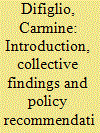

|
|
|
| 10 |
ID:
166466


|
|
|
|
|
| Summary/Abstract |
The Renewable Portfolio Standard (RPS) is widely considered the most important state-level renewable energy policy in the U.S. RPS policies are designed to move the state's electric sector toward renewables while minimizing electricity cost increases for customers but the specific design elements vary widely from state to state. And yet, the impacts of specific policy design features on outcomes has received relatively little attention in scholarly research. This study employs an in-depth case study approach to examine stakeholder perceptions of how and why particular policy design features of Nevada's RPS have changed as the result of social and political dynamics of Nevada's electric sector and the perceived impacts of these changes on policy outcomes. Although most expert stakeholders perceived Nevada's early RPS as critical to spurring growth in renewables, addition of a credit multiplier and allowance of existing and out-of-state resources, the long-term banking of RECs, credits for energy used to operate geothermal facilities, and energy efficiency measures were viewed as undermining policy objectives and delocalizing important economic and environmental benefits. Stakeholders perceived these changes as the result of an electric-sector culture that is resistant to change and a single, powerful electric utility that has significant sway over its regulator.
|
|
|
|
|
|
|
|
|
|
|
|
|
|
|
|
| 11 |
ID:
162286
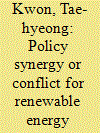

|
|
|
|
|
| Summary/Abstract |
Governments provide various incentives for the production of electricity from renewable energy sources (RES-E). South Korea has promoted the use of such electricity through various programmes, such as Feed-in Tariff from 2002 to 2011, and Renewable Portfolio Standard (RPS) since 2012. The RPS appears to have been particularly effective in stimulating the use of RES-E. However, there remain several issues regarding the current RPS’ policy design. This study examines South Korea's RPS by focusing on two issues. The first issue is the regulation of technology competition under the RPS; and the second issue is risk mitigation, which is generally known as a weakness of the RPS policy.
|
|
|
|
|
|
|
|
|
|
|
|
|
|
|
|
| 12 |
ID:
166961
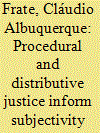

|
|
|
|
|
| Summary/Abstract |
Energy planners predict that in Brazil wind power will increase from 13.19 GW in 2018 to 28.47 GW in 2026. Conflicts focused on wind farms are appearing in Brazil, but thus far a justice perspective has not been applied to analyze conflicts. Increasingly, wind power acceptance is positively associated with several concerns regarding procedural and distributive justice, but empirical descriptions of how social actors interpret these concerns is in early stages. Identification of issues influencing acceptance is necessary to devise policies to facilitate wind power diffusion. This paper uses Q-method to determine empirically four factors or social perspectives in a coastal community in Rio Grande do Norte state: (1) Questioning Wind Power Benefits; (2) Wind Farm Boosters; (3) Compensated by Power and (4) Questioning Wind Farm Processes. Procedural and distributive justice concerns, especially the distribution of perceived benefits and negative impacts of wind farms and critiques of the decision-making processes, structure these social perspectives. Identification of social perspectives may improve decision-making process capacity for procedural and distributive justice.
|
|
|
|
|
|
|
|
|
|
|
|
|
|
|
|
| 13 |
ID:
111090


|
|
|
|
|
| Publication |
2012.
|
| Summary/Abstract |
Utilization of renewable energy technologies remains one of the major energy policies throughout the world. These technologies are proven to be successful for electrifying rural communities, especially in developing countries. Realizing the benefits of renewable energy sources, the Government of Nepal has initiated the production and distribution of renewable energy technologies in recent years, mainly to electrify rural communities. Although these technologies are suitable for providing electricity in isolated and remote rural areas, their implementation programs have not been successful as expected. This review provides broad-spectrum view about the energy situation in Nepal and highlights the current policies and subsidies for the optimal utilization of renewable energy resources in isolated and poor rural communities. In addition, major promotional barriers for their implementation in Nepal have been discussed.
|
|
|
|
|
|
|
|
|
|
|
|
|
|
|
|
| 14 |
ID:
083791
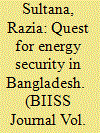

|
|
|
|
|
| Publication |
2008.
|
| Summary/Abstract |
Energy security is one of the major policy concerns for Bangladesh. Currently, the country with its vast population is facing formidable challenges in supplying energy in spite of having some mineral resources and significant amount of renewable resources options. To understand the overall energy scenario of the country, existing reserves of renewable and non-renewable energy resources have been discussed in the paper. In the energy security context, several issues such as export of gas, electricity shortage and high dependency on imported oil are real threats to ensuring supply of energy to meet the growing demand. These issues have been discussed within the conceptual framework of energy security for the country's rapid economic growth. To overcome the challenges, sustainable energy development through intra-regional cooperation with SAARC, BIMSTEC and extra-regional collaboration with the OPEC countries has also been touched upon in the paper.
|
|
|
|
|
|
|
|
|
|
|
|
|
|
|
|
| 15 |
ID:
097201
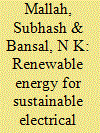

|
|
|
|
|
| Publication |
2010.
|
| Summary/Abstract |
Present trends of electrical energy supply and demand are not sustainable because of the huge gap between demand and supply in foreseeable future in India. The path towards sustainability is exploitation of energy conservation and aggressive use of renewable energy systems. Potential of renewable energy technologies that can be effectively harnessed would depend on future technology developments and breakthrough in cost reduction. This requires adequate policy guidelines and interventions in the Indian power sector. Detailed MARKAL simulations, for power sector in India, show that full exploitation of energy conservation potential and an aggressive implementation of renewable energy technologies lead to sustainable development. Coal and other fossil fuel (gas and oil) allocations stagnated after the year 2015 and remain constant up to 2040. After the year 2040, the requirement for coal and gas goes down and carbon emissions decrease steeply. By the year 2045, 25% electrical energy can be supplied by renewable energy and the CO2 emissions can be reduced by 72% as compared to the base case scenario.
|
|
|
|
|
|
|
|
|
|
|
|
|
|
|
|
| 16 |
ID:
175102
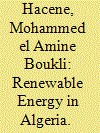

|
|
|
|
|
| Summary/Abstract |
Algeria, like other developing countries, has been committed to promoting the transition to renewable energy for several years. The national government established several laws and attractive subsidies that encouraged various socio-economic entities to use renewable energies and engage in more sustainable practices. Despite these efforts, industrial and private entities have not responded as hoped. To identify the factors that impede government efforts toward sustainable practices, this paper focuses on the two most energy-consuming sectors: building and transport. The analysis reveals that both financial and socio-cultural issues constitute the two main obstructive elements to energy transition in Algeria. This is the first study to be carried out in Algeria on technico-economic difficulties in the application of energy transition towards renewable sources.
|
|
|
|
|
|
|
|
|
|
|
|
|
|
|
|
| 17 |
ID:
171492
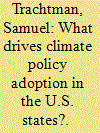

|
|
|
|
|
| Summary/Abstract |
Climate advocates increasingly view state policy as a crucial tool to reduce greenhouse gas emissions in the U.S. However, the literature lacks systematic empirical analysis of which, when, and why states adopt policies mitigating climate change. While traditional climate federalism highlights the co-benefits to climate policies in driving subnational policy decisions, more recent work emphasizes the powerful role of partisan control of office. I collect and analyze panel data measuring the strength of state policy from 2007 to 2014 in four areas: renewable portfolio standards, distributed generation, energy efficiency, and severance taxes on oil and gas extraction. While renewable portfolio standards and distributed generation policies were driven primarily by Democratic partisanship in state electorates, energy efficiency policies were less responsive to Democratic partisanship but marginally responsive to unified Democratic control of state government. Finally, these political factors did not measurably influence state severance taxes.
|
|
|
|
|
|
|
|
|
|
|
|
|
|
|
|
|
|
|
|
|